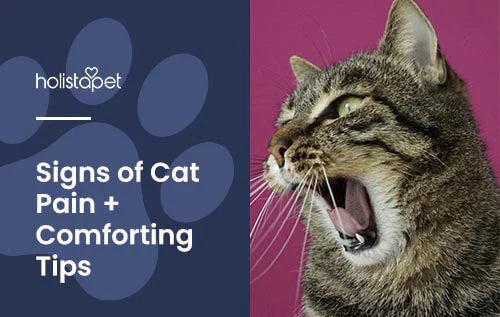Wondering how to tell if a cat is in pain? It can be tricky, but spotting clues early can help you give the best care for your feline friend. Cats are pretty good at hiding their discomfort, so knowing what to look for is crucial.
Are there recent changes in your pet's behavior? Do you notice any subtle signs of pain, like flinching? They may be going through something. To be sure, let's look at the common symptoms of pain in cats and what you can do about them.
Common Signs That a Cat Is in Pain
Cats often hide their discomfort as part of their survival instinct. Even as domesticated pets, they still want to avoid looking weak to predators. This behavior has made it challenging for many cat owners to notice when their pets are experiencing pain.
Paying close attention to even the smallest changes in your cat's behavior and physical condition is key. Many signs can point to discomfort and distress in felines (like the ones we'll discuss in the next sections). With early detection, your cat can receive the right treatment and dodge long-term pain.
Decreased Grooming
Cats are particular about cleanliness. But when they're in pain, they may groom themselves less. Discomfort can make it difficult for them to reach certain areas of their body. This grooming issue can lead to a dull, matted coat and uncomfortable skin irritation.
More Sleep, Less Activity
Cats may sleep more and play less to manage their aches and pains. If your typically active pet suddenly becomes a couch potato, they might be experiencing pain. Keep a close eye on your cat's activity levels to get clues about their condition.
Hiding and Uncharacteristic Aggression

A feline's survival instinct is to hide when they're feeling weak. They may also hiss, bite, or swat when approached. You can't blame them; it's their defense mechanism kicking in. If your usually friendly kitty starts hiding and becomes rather aggressive, it could be a sign they're in pain.
Decreased Appetite and Weight Loss
When our feline companions feel pain, they tend to eat less. Their drinking habits may change, too. Decreased appetite and water intake can lead not only to weight loss but also to other health problems. If you notice these warning signs, talk to your vet.
Discomfort When Touched
Cats experiencing pain might find your touch unbearable even if you mean well. They may flinch, growl, or bite when you pet them. This reaction is a big red flag. Try to identify your pet's pain points and let your veterinarian know. They can help figure out the issue behind your cat's pain.
Accidents Outside the Litter Box
Arthritis, urinary problems, or abdominal pain can make bathroom breaks painful for many cats. They may associate their litter box with discomfort. As a result, they may avoid going inside their litter box altogether. Avoid punishing your cat when they have accidents. Instead, look into the issue and report it to your vet.
Excessive Vocalization

Excessive meowing, yowling, or whining can point to pain in cats. Vocalization can be their way of communicating distress to their humans. If it's out of character for your cat to be persistently loud, check if they have any health problems.
Cat's Posture and Facial Expressions
Your cat's appearance can give clues, too. Cats in pain often adopt a hunched posture, with their head lowered and back arched. Their facial expression may show a vacant stare or narrowed eyes. Awareness of feline body language can help you tell if something's wrong.
Related Post: Are Cats in Pain When in Heat? [Feline Comfort During Estrus]
Causes of Pain in Cats
Knowing the source of your cat's pain is key to giving them the best care. Your cat may be hurting from an injury, illness, or chronic condition. From an ingrown claw to feline headaches, there are many causes of pain for cats. When you identify the root cause of their discomfort, you can take steps to get them feeling better again. Let's look at the possible reasons for your four-legged friend's aches and pains.
Ingrown Claws
When a cat's claws grow into their paw pads, it can cause swelling, redness, and infection. That's definitely painful and can cause limping. Ingrown claws are common in older cats or pets that don't wear down their nails naturally. What can you do? Easy — make it a habit to trim your pet's nails regularly.
Wounds
Adventurous felines may get injured from rough play, fights, or accidents. Minor cuts and scrapes are manageable. But you need to watch out for more severe cases. Regularly check your cat for serious wounds, especially if they go outdoors. If left untreated, cuts can get infected and cause bigger issues.
Surgery
Managing your cat's post-surgical pain aids recovery. After a major procedure, cats may have difficulty moving around. Their attitude might change, too. In such cases, your vet can provide meds or care tips to help speed up your cat's healing process.
Dental Disease

Dental issues like gingivitis and periodontal disease cause great pain in cats. Common signs of oral problems include bad breath, drooling, and difficulty eating. To avoid these hassles, schedule regular dental checkups and cleanings for your cat. Proper dental care is always the best defense against these conditions.
Eye Problems
Eye problems such as conjunctivitis, ulcers, and glaucoma can cause redness, swelling, and discharge. Affected cats may paw at their eyes, squint, or avoid bright lights altogether. If you think your pet needs help, talk to your vet. The earlier they can diagnose issues, the more your cat can avoid long-term pain.
Arthritis and Bone Disease
Older cats are more prone to arthritis and bone disease. These conditions can cause joint swelling, stiffness, reduced mobility, and chronic pain. If your senior cat has trouble jumping or climbing, they may need treatment to regain their agility and zest for life.
Urinary and Bladder Problems
Urinary tract infections, bladder stones, and cystitis cause frequent, painful urination. Cats with these conditions often strain in the litter box or have accidents outside it. In addition to your vet's help, make sure your kitty eats a balanced diet and drinks plenty of water. Also, observe your cat's bathroom habits to spot any early warning signs.
Related Post: Cat Urinary Blockage Home Remedy
Digestive Issues
Constipation, diarrhea, and stomach issues can cause serious pain and affect cats' appetites. Pay close attention to your pet's eating and bathroom habits. These can give you a better picture of your cat's digestive health. Pair this diligence with a proper diet, and your cat can keep those tummy troubles at bay.
Cancer
Cancer is a serious illness that can cause great pain in cats. Symptoms include lumps, loss of appetite, decreased weight, and lethargy. Early detection and treatment are crucial. Surgery, chemotherapy, and palliative care can help manage pain and slow down disease progression. Of course, your love and support will go a long way, too.
Suggestions To Comfort a Cat in Pain
No pet parent wants to see their furry buddy in pain. If your cat suffers from discomfort, there are ways to offer comfort:
- Seek Veterinary Care
- Try CBD for Cats
- Consider Supplements
- Apply Cold or Heat Therapy
-
Keep Them Safe and Comfortable
Related Post: What Can I Give My Cat For Pain Relief?
Seek Veterinary Care
The first step is to consult your vet. They can examine your cat and pinpoint the cause of their pain. Then, they can prescribe the right medications or therapies to target your kitty's discomfort. A trusted vet can help ease your worries and restore your cat to good health.
Try CBD for Cats
Did you know that CBD (cannabidiol) may help soothe your cat's aches and soreness? CBD promotes comfort, relaxation, and calm in a natural and safe way for cats.
HolistaPet's line of CBD products for cats is here for you. Our CBD hard treats, calming chews, capsules, and oils are well-tolerated by felines. Thousands of cat owners trust our products to help increase their pets' comfort levels. Our offerings are all-natural, gluten-free, dairy-free, non-GMO, lab-tested, and vet-approved for your peace of mind.
Consider Supplements
Supplements with glucosamine and chondroitin may help ease aching and sore joints. Omega-3 fatty acids are great, too, as they may soothe swelling. To use supplements, get the guidance and approval of your vet first. It may surprise you how, with the right products, your cat's life can change overnight.
Apply Cold or Heat Therapy
Cold packs help reduce swelling and numb pain. Meanwhile, heat therapy can help relax muscles and improve blood flow, soothing chronic pain. When trying these methods, use a barrier (like a cloth) between the pack and your pet's skin to prevent burns or frostbite. Ask your vet about the right type and duration of therapy for your cat.
Keep Them Safe and Comfortable
Adjust your home environment to suit your furry friend's needs, and they will be well on their way to recovery. Give them a quiet space to rest at home, away from all the chaos. Provide soft bedding for extra comfort if your cat suffers from joint issues. Their food, water, and litter box should also be easily accessible.
Related Post: How to Give a Cat a Pill [Simple Guide]
Can I Prevent My Cat From Developing Aches and Pains?
Cliché as it sounds, prevention is always better than cure. If you want to protect your cat from pain, keep these in mind:
- Balanced Diet. Can support overall health.
- Exercise. Can maintain a healthy weight and prevent strain on the joints and muscles.
- Regular Grooming. Can keep skin issues at bay.
- Play Sessions and Interactive Toys. Can provide mental and physical stimulation, reducing the risk of pain related to inactivity.
What Are the Signs That My Cat Is Feeling Better?
It shouldn't be hard to tell if your cat is getting back to normal. Here are some typical signs that they're getting better:
- Regularly Grooming Themselves
- Eating Well
- Moving and Playing More
- Becoming Social Again
- Less Hiding and Aggression
Conclusion - How To Tell if a Cat Is in Pain
It hurts to see our pets in pain. We just want to take all of their discomfort away. But hope is not lost. Now that you know all the warning signs to watch out for, the common causes of pain in cats, and what you can do to help, your feline friend is a step closer to getting their pizzazz back.
For additional support, visit our shop for some quality cat wellness products. With the right attention and care, your best friend can live a comfortable life with you right by their side.
Read Next: Recovery Suit for Cats: Promotes Stress-Free Healing



 CBD Oil for Cats - Fast Acting
CBD Oil for Cats - Fast Acting
 CBD Cat Treats - Easy Dose
CBD Cat Treats - Easy Dose
 CBD Calming Chews for Cats - Highly Rated
CBD Calming Chews for Cats - Highly Rated
 CBG Oil for Dogs and Cats - Loved by Thousands
CBG Oil for Dogs and Cats - Loved by Thousands





Leave a comment
All comments are moderated before being published.
This site is protected by hCaptcha and the hCaptcha Privacy Policy and Terms of Service apply.